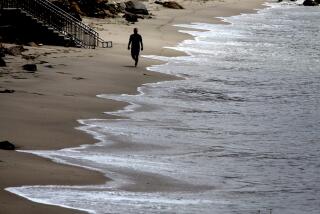Time for a Pollution Solution
- Share via
As disturbing as the recent closure of nearly a half-mile of shoreline in Huntington Beach is, at least the city and public health officials have the benefit of painful experience to guide them this time around. They ought to take advantage of it, and not wait for another lost summer before broadening the search for suspects beyond local sewage leaks. Every effort must be made to identify and correct the source of high bacterial counts to avoid a repeat performance of the brutal season of 1999, when miles of waterfront were off-limits.
In recent days, the news from the Huntington shore has been like an echo of the past. First, high bacteria counts prompted the Orange County Health Care Agency to indefinitely close a stretch to swimmers and surfers. Then the hunt for a source began in earnest, first zeroing in on restrooms suspected of leaking human waste into the surf.
Back in 1999, when officials also found high bacteria counts, they began their search at the same place. The search identified a few leaks but gradually the sleuths came to understand that the source of pollution that closed stretches of beach to swimmers for much of the summer would be much harder to identify.
The hoped-for result from any beach closing is that the source of the pollution will be identified quickly, and that the problem can be remedied without being prohibitively expensive. When a lot of money is spent to identify a problem, and there still is no definite answer, the search becomes frustrating. That is in addition to the dislocation that occurs when the local economy suffers from lost tourism.
The city, county, Orange County Sanitation District and other agencies already have poured millions into the effort to find out what has been going on in recent years offshore at Huntington Beach. Still, there are the lingering concerns about the effects of the giant offshore sewage plume, released more than four miles offshore by the sanitation district. The district long has maintained that its partially treated sewage, permissible under a waiver from the Clean Water Act, stays harmlessly offshore. But a recent study by the Scripps Institute of Oceanography and UC Irvine raises questions. The district’s waiver already is being widely challenged, and it will have to make a decision soon whether to reapply. Surely it should know whether there is any link between the recent pollution problem and the plume. There are immediate and long-term reasons why the region needs to know more about this pollution.
This time, there already is the record of all that sleuthing along local sewer lines to suggest that a broader source of pollution needs to be considered sooner, rather than later. Don’t leave anything to chance this time, which would only invite longer delays in taking action and open the possibility of another lost summer.
Whatever the pollution source is, it should be identified and addressed now.
More to Read
Sign up for Essential California
The most important California stories and recommendations in your inbox every morning.
You may occasionally receive promotional content from the Los Angeles Times.










